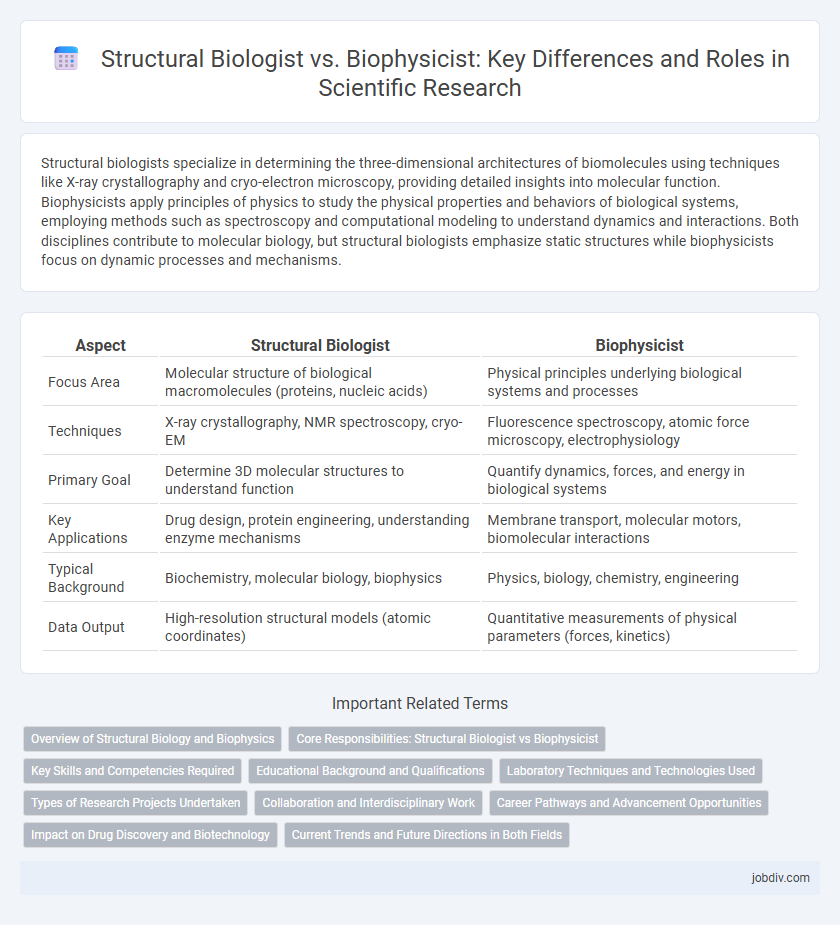Structural biologists specialize in determining the three-dimensional architectures of biomolecules using techniques like X-ray crystallography and cryo-electron microscopy, providing detailed insights into molecular function. Biophysicists apply principles of physics to study the physical properties and behaviors of biological systems, employing methods such as spectroscopy and computational modeling to understand dynamics and interactions. Both disciplines contribute to molecular biology, but structural biologists emphasize static structures while biophysicists focus on dynamic processes and mechanisms.
Table of Comparison
| Aspect | Structural Biologist | Biophysicist |
|---|---|---|
| Focus Area | Molecular structure of biological macromolecules (proteins, nucleic acids) | Physical principles underlying biological systems and processes |
| Techniques | X-ray crystallography, NMR spectroscopy, cryo-EM | Fluorescence spectroscopy, atomic force microscopy, electrophysiology |
| Primary Goal | Determine 3D molecular structures to understand function | Quantify dynamics, forces, and energy in biological systems |
| Key Applications | Drug design, protein engineering, understanding enzyme mechanisms | Membrane transport, molecular motors, biomolecular interactions |
| Typical Background | Biochemistry, molecular biology, biophysics | Physics, biology, chemistry, engineering |
| Data Output | High-resolution structural models (atomic coordinates) | Quantitative measurements of physical parameters (forces, kinetics) |
Overview of Structural Biology and Biophysics
Structural biology investigates the three-dimensional architecture of biological macromolecules using techniques like X-ray crystallography, NMR spectroscopy, and cryo-electron microscopy to understand protein folding, dynamics, and interactions. Biophysics applies physical principles and quantitative methods to study the mechanical, electrical, and thermodynamic properties of biological systems, often integrating computational modeling and single-molecule approaches. Both fields contribute to elucidating molecular mechanisms underlying cellular functions but differ in focus: structural biology emphasizes molecular structure determination, whereas biophysics explores functional dynamics and physical behavior.
Core Responsibilities: Structural Biologist vs Biophysicist
Structural biologists specialize in elucidating the three-dimensional architectures of biomolecules using techniques like X-ray crystallography and cryo-electron microscopy to understand molecular function and interactions. Biophysicists apply physical principles and quantitative methods such as spectroscopy and computational modeling to study the dynamics, energetics, and mechanical properties of biological systems. Both disciplines contribute to molecular-level insights but differ in methodological emphasis, with structural biologists focusing on static structures and biophysicists on dynamic processes.
Key Skills and Competencies Required
Structural biologists require expertise in X-ray crystallography, NMR spectroscopy, and cryo-electron microscopy to elucidate macromolecular structures at atomic resolution. Biophysicists must possess strong skills in quantitative analysis, computational modeling, and biophysical techniques such as single-molecule fluorescence and atomic force microscopy. Both disciplines demand proficiency in molecular biology, data interpretation, and interdisciplinary collaboration to advance understanding of biomolecular mechanisms.
Educational Background and Qualifications
Structural biologists typically hold advanced degrees in biology, biochemistry, or molecular biology, with extensive training in X-ray crystallography, NMR spectroscopy, and cryo-electron microscopy to determine macromolecular structures. Biophysicists often possess interdisciplinary education combining physics, chemistry, and biology, emphasizing quantitative analysis, mathematical modeling, and experimental techniques like spectroscopy and single-molecule methods. Both fields require strong backgrounds in molecular sciences, but structural biology focuses more on macromolecular structure determination, while biophysics integrates physical principles to study biological systems.
Laboratory Techniques and Technologies Used
Structural biologists primarily utilize X-ray crystallography, cryo-electron microscopy, and NMR spectroscopy to determine atomic-level structures of biomolecules. Biophysicists employ techniques such as fluorescence spectroscopy, atomic force microscopy, and single-molecule force spectroscopy to analyze the physical properties and dynamics of biological systems. Both fields rely on advanced computational tools for data analysis and molecular modeling to interpret experimental results.
Types of Research Projects Undertaken
Structural biologists primarily investigate the three-dimensional architecture of biomolecules using techniques such as X-ray crystallography, NMR spectroscopy, and cryo-electron microscopy to understand molecular functions and interactions. Biophysicists focus on quantitative analysis of biological systems, employing methods like single-molecule force spectroscopy and computational modeling to explore the physical principles underlying cellular processes. Research projects in structural biology often center on elucidating protein folding and ligand binding, whereas biophysics projects encompass membrane dynamics, molecular mechanics, and bioenergetics.
Collaboration and Interdisciplinary Work
Structural biologists and biophysicists often collaborate to elucidate macromolecular structures using complementary techniques such as X-ray crystallography, NMR spectroscopy, and cryo-electron microscopy, enhancing the accuracy of biomolecular models. Interdisciplinary work between these fields integrates computational modeling and experimental data, facilitating a deeper understanding of protein dynamics, folding mechanisms, and interactions critical for drug design. This synergy accelerates discoveries in molecular biology by combining expertise in atomic-scale structure determination and biophysical analysis of molecular behavior.
Career Pathways and Advancement Opportunities
Structural biologists typically advance by specializing in high-resolution techniques such as X-ray crystallography, cryo-electron microscopy, and NMR spectroscopy to elucidate molecular architectures, often transitioning into academia or pharmaceutical research roles. Biophysicists pursue career growth through interdisciplinary expertise in physics, biology, and computational modeling, enabling them to innovate in areas like membrane dynamics, protein folding, and cellular biomechanics, with opportunities in biotech industries and national laboratories. Both fields emphasize continuous skill development in advanced imaging and analytical technologies to secure leadership positions and influence drug discovery and molecular design.
Impact on Drug Discovery and Biotechnology
Structural biologists elucidate the three-dimensional architecture of biomolecules using techniques such as X-ray crystallography and cryo-electron microscopy, providing critical insights into molecular targets for drug design. Biophysicists analyze the physical principles governing biomolecular interactions and dynamics, enabling the optimization of drug efficacy and stability through computational modeling and biophysical assays. Together, these disciplines drive innovations in drug discovery and biotechnology by integrating structural data with functional mechanisms to accelerate the development of targeted therapeutics.
Current Trends and Future Directions in Both Fields
Structural biologists leverage advanced cryo-electron microscopy and X-ray crystallography to elucidate macromolecular architectures, driving insights into protein dynamics and interaction networks. Biophysicists employ cutting-edge single-molecule techniques and computational modeling to explore molecular mechanisms and energy landscapes, enhancing understanding of biomolecular functions under physiological conditions. Emerging trends emphasize integrative approaches combining experimental methods with machine learning algorithms, paving the way for personalized drug design and real-time biomolecular analysis.
Structural Biologist vs Biophysicist Infographic

 jobdiv.com
jobdiv.com